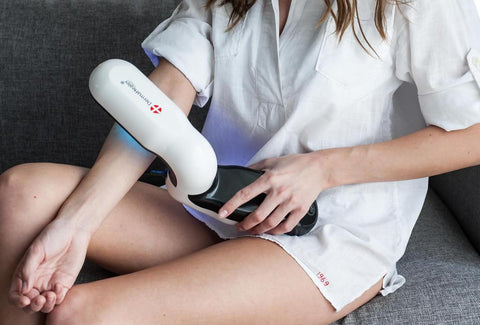How Does Phototherapy Work in Dermatology?
Phototherapy, also called light therapy, mimics the effects of sunlight exposure. UV light from artificial sources is used to trigger biologic processes that reduce inflammation and prevent skin cells from growing too quickly. Frequently exposing the affected area to this type of light controls inflammation and helps clear the skin.
Ultraviolet light shuts down immune system cells in the skin. It can help in skin diseases that are caused by an overreaction of the immune system. Skin disorders that are treated with phototherapy include:
- Eczema — an itchy, red skin condition due to allergies
- Psoriasis — a skin disease that causes red, silvery, scaly patches on the skin.
- Mycosis fungoides — a type of lymphoma confined to the skin.
- Vitiligo — a disorder where normal skin pigment is lost due to destruction of pigment-producing cells by the immune system.
What is ultraviolet light?
There are different types of ultraviolet light that are part of the electromagnetic spectrum. The sun generates UV light that reaches the earth. Ultraviolet light helps you produce vitamin D, which is essential to help your body survive, though too much UV exposure can damage your skin.
The ultraviolet light used in phototherapy is the same type of light emitted from the sun. Your dermatologist will determine the strength of the light and monitor the length of time that your skin can be exposed to UV light to prevent skin damage.
Still, there are those who cannot benefit from phototherapy because it can do more harm than treat their skin condition. Phototherapy is not advisable to those who suffer from:
- Bloom Syndrome
- Dermatomyositis
- Dysplastic Naevus Syndrome
- Genetic Skin Cancer Syndromes
- Systemic Lupus Erythematosus
Planning Your Phototherapy Sessions
Phototherapy sessions are usually done in your skin doctor’s office but if you will need long-term therapy, you can talk to your dermatologist about doing treatment from your home using a phototherapy lamp. At-home treatment can be helpful for treating flares and keeping your skin condition under control.
Most patients need two or three phototherapy treatments a week for it to be effective. In some cases, you may need to go five times a week.
There are different types of phototherapies. The most common types that dermatologists prescribe are:
UVB Light
Patients stand in a light box or a UVB lamp is placed over the affected skin.
Laser Treatment
The dermatologist uses laser to deliver high doses of light only to the affected skin.
PUVA Bath
Patients are made to soak in water that contains psoralen, which makes the skin more sensitive to UV light. After soaking, they then wait for a specified time and receive UVA light treatment.
PUVA with Pills
Patients take psoralen pills, wait for about 45 to 60 minutes, and then receive UVA light treatment.
Is phototherapy safe?
Phototherapy is safe, though it can cause short-term side effects. Most are mild, and may include:
- blistering
- dryness
- itching
- pain
- redness
- tenderness
- tightness
You may experience additional side effects if you take medication alongside phototherapy. For instance, PUVA treatment has been linked to fever and nausea.
According to a 2019 study, UVB phototherapy is not linked to an increased risk of skin cancer. However, PUVA treatment has been related to an increase in squamous cell carcinoma, particularly after many phototherapy sessions. Thus, it is not prescribed as frequently unlike with the UVB phototherapy.

